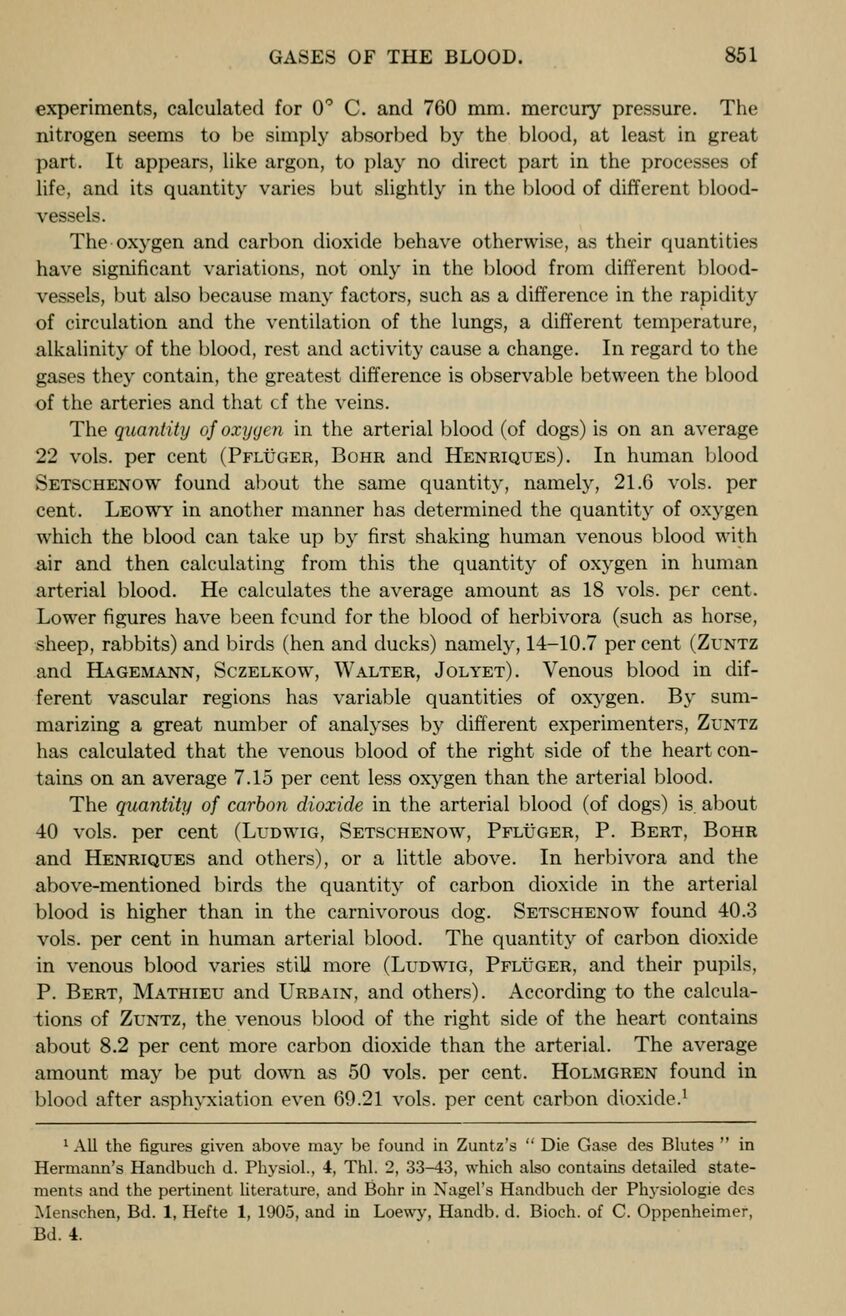
Full resolution (JPEG) - On this page / på denna sida - XVI. Respiration and Oxidation - I. The Gases of the Blood

<< prev. page << föreg. sida << >> nästa sida >> next page >>
Below is the raw OCR text
from the above scanned image.
Do you see an error? Proofread the page now!
Här nedan syns maskintolkade texten från faksimilbilden ovan.
Ser du något fel? Korrekturläs sidan nu!
This page has never been proofread. / Denna sida har aldrig korrekturlästs.
GASES OF THE BLOOD. 851
experiments, calculated for 0° C. and 760 mm. mercury pressure. The
nitrogen seems to be simply absorbed by the blood, at least in great
part. It appears, like argon, to play no direct part in the processes of
life, and its quantity varies but slightly in the blood of different blood-
vessels.
The oxygen and carbon dioxide behave otherwise, as their quantities
have significant variations, not only in the blood from different blood-
vessels, but also because many factors, such as a difference in the rapidity
of circulation and the ventilation of the lungs, a different temperature,
alkalinity of the blood, rest and activity cause a change. In regard to the
gases they contain, the greatest difference is observable between the blood
of the arteries and that cf the veins.
The quantity of oxygen in the arterial blood (of dogs) is on an average
22 vols, per cent (Pfluger, Bohr and Henriques). In human blood
Setschenow found about the same quantity, namely, 21.G vols, per
cent. Leowy in another manner has determined the quantity of oxygen
which the blood can take up by first shaking human venous blood with
air and then calculating from this the quantity of oxygen in human
arterial blood. He calculates the average amount as 18 vols, per cent.
Lower figures have been found for the blood of herbivora (such as horse,
sheep, rabbits) and birds (hen and ducks) namely, 14-10.7 per cent (Zuntz
and Hagemann, Sczelkow, Walter, Jolyet). Venous blood in dif-
ferent vascular regions has variable quantities of oxygen. By sum-
marizing a great number of analyses by different experimenters, Zuntz
has calculated that the venous blood of the right side of the heart con-
tains on an average 7.15 per cent less oxygen than the arterial blood.
The quantity of carbon dioxide in the arterial blood (of dogs) is about
40 vols, per cent (Ludwig, Setschenow, Pfluger, P. Bert, Bohr
and Henriques and others), or a little above. In herbivora and the
above-mentioned birds the quantity of carbon dioxide in the arterial
blood is higher than in the carnivorous dog. Setschenow found 40.3
vols, per cent in human arterial blood. The quantity of carbon dioxide
in venous blood varies still more (Ludwig, Pfluger, and their pupils,
P. Bert, Mathieu and Urbain, and others). According to the calcula-
tions of Zuntz, the venous blood of the right side of the heart contains
about 8.2 per cent more carbon dioxide than the arterial. The average
amount may be put down as 50 vols, per cent. Holmgren found in
blood after asphyxiation even 69.21 vols, per cent carbon dioxide. 1
1
All the figures given above may be found in Zuntz ’s " Die Gase des Blutes " in
Hermann’s Handbuch d. Physiol., 4, Thl. 2, 33-43, which also contains detailed state-
ments and the pertinent literature, and Bohr in Xagel’s Handbuch der Physiologie dcs
Menschen, Bd. 1, Hefte 1, 1905, and in Loewy, Handb. d. Bioch. of C. Oppenheimer,
Bd. 4.
<< prev. page << föreg. sida << >> nästa sida >> next page >>